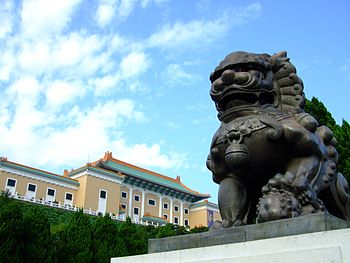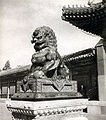- Chinese guardian lions
-
This article is about Chinese guardian lions. For the Chinese dog breeds called Foo Dogs, see Foo Dog.
Chinese guardian lions, known as Shishi lions (Chinese: 石獅; pinyin: shíshī; literally "stone lion") or Imperial guardian lion, and often incorrectly called "Foo Dogs" in the West, are a common representation of the lion in pre-modern China. They have traditionally stood in front of Chinese Imperial palaces, Imperial tombs, government offices, temples, and the homes of government officials and the wealthy, from the Han Dynasty (206 BC-AD 220), and were believed to have powerful mythic protective benefits. Pairs of guardian lions are still common decorative and symbolic elements at the entrances to restaurants, hotels, supermarkets and other structures, with one sitting on each side of the entrance, in China and in other places around the world where the Chinese people have immigrated and settled, especially in local Chinatowns.
 A Qing-era guardian lion pair within the Forbidden City. Note the different appearance of the face and details in the decorative items, compared to the earlier Ming version
A Qing-era guardian lion pair within the Forbidden City. Note the different appearance of the face and details in the decorative items, compared to the earlier Ming version
The lions are always created in pairs, with the male resting his paw upon the world and the female restraining a playful cub that is on its back. They occur in many types of Chinese pottery and in Western imitations.[1]
Contents
Etymology
and less commonly:
- Auspicious lion (瑞獅, Pinyin: Ruìshī): respecting reference to the Tibetan Snow Lion or with context to good fortune
- Fortuitous lion (福獅, Pinyin: fúshī)[citation needed]: reference in context to good fortune
- Buddha's or Buddhist lion (佛獅, Pinyin: fóshī)[citation needed]: reference in a religious context to the lion as protector of Buddha
 A statue of a Shishi looking over Mount Emei, China
A statue of a Shishi looking over Mount Emei, China
In Asian cultures:
- In Japan: the lion figures are known as Komainu (狛犬・高麗犬, lit Korea dogs) possibly due to their introduction to Japan through Korea.
- In Myanmar: called Chinthe and gave their name to the World War II Chindit soldiers.
- In Okinawa: similar lion formed statuettes are known as Shisa.
- In Tibet: known as a Snow Lion
Western names
In English and several Western languages, the guardian lions are often referred in a multitude of name such as: "Fu Dogs",[2] "Foo Dogs", "Fu Lions", "Fo Lions", and "Lion Dogs".[3] The term "Fo" or "Fu" may be transliterations to the words 佛 (pinyin: fó) or 福 (pinyin: fú), which means "buddha" or "prosperity" in Chinese, respectively. However, Chinese reference to the guardians lion are seldom prefixed with 佛 or 福, and more importantly never referred to as "dogs".
Reference to guardian lions as dogs in Western cultures may be due to the Japanese reference to them as "Korean dogs" (狛犬・高麗犬) due to their transmission from China through Korea into Japan. It may also be due to the misidentification of the guardian lion figures as representing certain Chinese dog breeds such as the Chow Chow (鬆獅犬, Pinyin: sōngshī quǎn, lit. "puffy-lion dog") or Shih Tzu (獅子狗; Pinyin: Shīzi Gǒu, lit. "lion dog").
Appearance
The lions are traditionally carved from decorative stone, such as marble and granite or cast in bronze or iron. Because of the high cost of these materials and the labor required to produce them, private use of guardian lions was traditionally reserved for wealthy or elite families. Indeed, a traditional symbol of a family's wealth or social status was the placement of guardian lions in front of the family home. However, in modern times less expensive lions, mass produced in concrete and resin, have become available and their use is therefore no longer restricted to the elite.
The lions are always presented in pairs, a manifestation of yin and yang, the female representing yin and the male yang. The male lion has its right front paw on an embroidered ball called a "xiù qiú" (绣球), which is sometimes carved with a geometric pattern known in the West as the "Flower of life" The female is essentially identical, but has a cub under the closer (left) paw to the male, representing the cycle of life. Symbolically, the female fu lion protects those dwelling inside, while the male guards the structure. Sometimes the female has her mouth closed, and the male open. This symbolizes the enunciation of the sacred word "om". However, Japanese adaptions state that the male is inhaling, representing life, while the female exhales, representing death. Other styles have both lions with a single large pearl in each of their partially opened mouths. The pearl is carved so that it can roll about in the lion's mouth but sized just large enough so that it can never be removed.
According to feng shui, correct placement of the lions is important to ensure their beneficial effect. When looking out of a building through the entrance to be guarded, looking in the same direction as the lions, the male is placed on the left and the female on the right. So when looking at the entrance from outside the building, facing the lions, the male lion with the ball is on the right, and the female with the cub is on the left.
History
The Asiatic lions were once quite common throughout its historic range in Southwest and Central Asia and are believed to be the ones depicted by the guardian lions in Chinese culture.[4] With increased trade during the Han dynasty and cultural exchanges through the Silk road, lions were introduced into China from the ancient states of Central Asia by peoples of Sogdiana, Samarkand, and the Yuezhi (月氏) in the form of pelts and live tribute, along with stories about them from Buddhist priests and travelers of the time.[5] This exchange can be seen in that the Chinese word for lion is "Shi" (師, later 獅/狮), which shares the same etymological roots as "Shiar" (شیر), the Persian language name for the animal.
Several instances of lions as imperial tributes from Central Asia was recorded in the document Book of the Later Han (後漢書) written from 25-220CE. On one particular event, on the eleventh lunar month of 87 CE, "... an envoy from Parthia offered as tribute a lion and an ostrich"[6] to the Han court. Indeed the lion was associated by the Han Chinese to earlier venerated creatures of the ancient Chinese, most notably by the monk Huilin (琳说) who stated that "the mythic suanni (狻猊) is actually the lion, coming from the Western Regions" (狻猊即狮子也,出西域).
The Buddhist version of the Lion was originally introduced to Han China as the protector of dharma and these lions have been found in religious art as early as 208 BC. Gradually they were incorporated as guardians of the Chinese Imperial dharm. Lions seemed appropriately regal beasts to guard the emperor's gates and have been used as such since. There are various styles of guardian lions reflecting influences from different time periods, imperial dynasties, and regions of China. These styles vary in their artistic detail and adornment as well as in the depiction of the lions from fierce to serene.
Although the form of the Chinese guardian lion was quite varied during its early history in China, the appearance, pose, and accessories of the lions eventually became standardized and formalized during the Ming and Qing dynasties into more or less its present form.
Image gallery
-
A sitting lion statue, celadon, 11th to 12th century, Song Dynasty.
-
Female guardian lion with her cub at the Summer Palace, Beijing- late Qing Dynasty, but in the Ming style
-
Standing lion at the Ming Dynasty Tombs Spirit Way
-
Imperial guardian lion outside Ngee Ann City in Singapore
Literary References
- In the novelet "White Magic" by Albert E. Cowdrey (Magazine of Fantasy & Science Fiction, March 1998), the protaganist has a "foo" lion/dog that serves as his "familiar" and comes alive, when necessary, to protect him and his neighbors.
- Within the planned spinoffs of the comics based on the Gargoyles Disney TV animated series, the "timedancing" gargoyle Brooklyn receives a green-skinned, leonine gargoyle beast that is named "fu-dog" from the Western name of the guardian lion statuary.
- Stone lions feature in a well-known Chinese tongue-twister: sì shì sì, shí shì shí, shí sì shì shí sì, sì shí shì sì shí, sì shí sì zhī shí shī zǐ shì sǐ de. (4 is 4, 10 is 10, 14 is 14, 40 is 40, 44 stone lions are dead.)
See also
- Lion dog, dog breeds originating in China that resemble "Chinese guardian lions" and hence are also called Foo or Fu Dogs or Lion Dogs.
- Culture of China
- Chinese dragon
- Door god
- Lion dance, another use of lion imagery in costume and motion.
- Shisa similar lion statues on the islands of Okinawa, Japan
- Nian to compare with a similar but horned (unicorn) mythical beast
- Pixiu to compare with a similar but winged mythical beast
- Haetae to compare with similar lion-like statues in Korea
- Komainu to compare its use in Japanese culture
- Chinese mythology
- Asiatic lions found in nearby India are the ones depicted in the Chinese culture.
- Tibetan Snow Lion
- Traditional Chinese Lions (Indianapolis Zoo)
- Medici lions
Notes
- ^ Lion of Fo. (2008). In Encyclopædia Britannica. Retrieved July 21, 2008, from Encyclopædia Britannica Online
- ^ D. Eastlake, C. Manros, and E. Raymond, RFC 3092: Etymology of "Foo", The Internet Society, April 1, 2001.
- ^ Article Lion of Fo at the Online version of Encyclopædia Britannica.
- ^ Where does the Lion come from in ancient Chinese culture? Celebrating with the Lion Dance by B. N. Goswamy, October 6, 2002, The Tribune Newspaper, Chandigarh, India
- ^ Schafer, Edward H. (1963). The Golden Peaches of Samarkand, a Study of T'ang Exotics. University of California Press.
- ^ "安息國遣使獻師子及條枝大爵" 後漢書, 和帝, Scroll 4)
External links
- World heritage immersive panorama In this immersive panorama from the Imperial Palace Museum, Beijing, your viewpoint will be near a large bronze lion, the female whose male counterpart's image is in the gallery above, at the Gate of Supreme Harmony.
- A webpage with pictures of a variety of Chinese stone lions.
Chinese mythology Overview topics Major entities Creatures Bixie · Black Tortoise · Azure Dragon · White Tiger · Vermilion Bird · Qilin · Fenghuang · Huli jing · Chinese guardian lions · Píxiū · NiánPlaces Popular literary works Shan Hai Jing · Shi Yi Ji · The Peach Blossom Spring · Fengshen Bang · Legend of the White Snake · Strange Stories from a Chinese Studio · Journey to the West · In Search of the Supernatural · Zi Bu Yu · Tian Xian PeiCategories:- Chinese architectural history
- Chinese mythology
- Mythological dogs
- Chinese culture
- Buddhist mythology
- Lions in art
Wikimedia Foundation. 2010.










